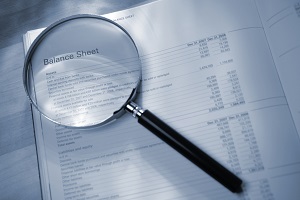
How much thought have you put into your financial health? As an investor (or aspiring investor), hopefully you’ve thought about it at least a little bit, and potentially a lot more than that.
Over the next few weeks, I’m going to post some thoughts I have on financial health, how to evaluate yours (or your company’s) and how to best position yourself to ensure that you and your company remain healthy enough to pursue all your investing goals. In this post, I’m going to start with a very simple, yet very powerful, concept in helping to analyze your financial health — it’s called the Balance Sheet.
The Balance Sheet is where you (or your company) itemizes all of its assets and liabilities into a single location, adds them together, and comes out with a number that indicates how much you (or your company) is worth. In other words, the Balance Sheet represents your net worth at a given point in time.
Below, I teach you how to create your own Balance Sheet, and I’ll even provide an Excel template you can use. In future posts, we will analyze your balance sheet to determine where and how to focus your efforts on improving your financial health.
Step #1: List Your Assets
The first component of a balance sheet is a list of owned assets and their values. For the sake of creating a balance sheet, assume an asset is anything that could readily be converted to cash.
Note: While some people believe that – for various reasons – houses and cars should not be considered assets, this is more of an investment philosophy and isn’t applicable when creating a balance sheet or determining net worth. When creating a balance sheet, all property that could be converted to cash should be considered an asset.
So, in addition to you car and your house (if you own one), the following could be considered assets:
- Any cash you have in the bank
- Any investments that you fully own
- Retirement savings
- Life insurance policies
- The value of any antiques, jewelry, or high-value items you own
When trying to determine the value of your assets, be conservative. Your car isn’t worth as much as it was when you bought it (use Kelly Blue Book to find out what it is worth), and your antiques and doll collections are only worth what someone else will pay for it (check eBay to see what similar items are being sold for).
Step #2: List Your Liabilities
The second piece of the balance sheet is the list of liabilities. Liabilities refer to any financial obligations you have, including any money you owe, credit card debt, the balance of your mortgage(s), and any other loans or obligations you have. For your balance sheet, you want to list each of the liabilities you have, along with the total dollar amount you owe on each.
And again, like with the assets, you should be conservative in your assessment; you’d rather appear to have less than you do than to actually have less than you think you do.
Step #3: Calculate Your Net Worth
Now this is the easy part. Once you have your list of assets (and their values) and your list of liabilities (and how much you owe on each), all you have to do is subtract the total value of your liabilities from the total value of your assets, and the resulting number is your net worth:
Net Worth = Assets – Liabilities
To download a template Balance Sheet that you can fill in yourself, click here.




Very solid explanation of balance sheets here! It’s a basic but necessary tool for people wanting to get into flipping real estate. The template looks very handy for people just starting out who need a guide. Thanks so much for sharing!
I was reading your book “The Book on Flipping Houses” and I am very curious why you wouldn’t use cash to fund your flips. I could see financing deals while starting out but in your breakdown of lender fees and Mortgage payments you spend $4500 just to finance a deal. I am super new to this. Am I missing something here? Could you go into detail why you would choose this over using cash for your flips. Thanks so much for all the great info you provide! Loving your book btw. Keep up the good work!
Hey Brian,
I will definitely use cash on occasion, but here’s my rationale for sometimes using financing:
1. Leverage: By financing, I’m increasing the returns I’m seeing on my investments. I’m generating lower profits on each one (due to the fees you mention), but my ROI is higher. If I can put all my cash to work using leverage, I will ultimately see greater profits across the portfolio (even though each individual deal is smaller profit).
2. Rainy Day: I like to know that I have cash available for a rainy day. In other words, if a great deal comes along that requires me to buy with cash (for example, a seller who needs to close in three days), I want to have cash available so I don’t miss that opportunity.
3. Build Relationships: Having good relationships with lenders may be important for future plans. Taking out loans is a great way to foster these relationships for the future.
4. Ability to do more deals: When I borrow, I can do more deals simultaneously than I can if I’m paying all cash. This helps me scale the business.
[…] Top post: Building Your Balance Sheet […]
[…] Top post: Building Your Balance Sheet […]